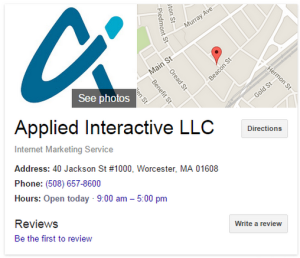Here at Applied Interactive, a lot of what we do every day is to make sure our clients’ content is being picked up by search engines and that the keywords contained therein are being indexed as quickly as possible. Not surprisingly, social media plays an integral role in our strategy.
 Despite its slow adoption rate compared to other social networks, Google+ is one of the more important social networks we use for this purpose. Due in large part to its connection to the parent company, it has become an invaluable tool for aiding organic search. For instance, when using Google to search for a brand or product name, it instills confidence in buyers when an information box pops up with that company’s location and other information. The content displayed in these boxes is sourced and updated from the business’ Google+ page.
Despite its slow adoption rate compared to other social networks, Google+ is one of the more important social networks we use for this purpose. Due in large part to its connection to the parent company, it has become an invaluable tool for aiding organic search. For instance, when using Google to search for a brand or product name, it instills confidence in buyers when an information box pops up with that company’s location and other information. The content displayed in these boxes is sourced and updated from the business’ Google+ page.
However, this may soon be changing.
After several years of lukewarm success, it seems Google+ may soon be a thing of the past. Bradley Horowitz, a product consumer applications VP at Google since 2008, confirmed this month that he will be taking over the search engine giant’s social network. He will be replacing David Besbris, who spent less than a year in the position. However, Horowitz never actually used the phrase “Google+” to refer to his new role. Instead, he used the more ambiguous phrase “Google’s Photos and Streams”.
“Just wanted to confirm that the rumors are true — I’m excited to be running Google’s Photos and Streams products!” Horowitz wrote on his Google+ account. If you were wondering, it does not appear to be a one-time mistake: Horowitz also uses the same phrase for his job title on LinkedIn.
So far, from a user perspective, not much has changed about the social network, but it seems the way it’s being framed internally is shifting. Sundar Pichai, Google’s senior VP of products, talked briefly about the decision at Mobile World Congress on Monday. “We have entered the stage where… photos and communications are big steps for standalone use cases. We will think of the stream first and then photos and communications as big areas. Internally, we are organizing that way to support that and you will see us evolve.”
Arguably the shift in strategy has been a long time coming. Google + was launched nearly 4 years ago after a series of failed attempts to break into the social network sphere. Some users may remember Orkut or the disastrous Google Buzz, which collapsed under the weight of messy privacy issues. Seeking to rise from the ashes of the Buzz failure, Google embarked on a 100-day plan to create what would become Google+. Although it received plenty of press after it’s initial launch in 2011, interest eventually fizzled, leaving behind a small core group of users.
Google’s desire to create a social network of it’s own is motivated by a need to compete with Facebook who had begun amassing data on its users; information that would prove invaluable to advertisers. Google’s ultimate goal was to keep users logged in, creating a universal identity for those who use their suite of products.
That ability to create an identity won’t go away. By splitting Google+ into parts, Google may be able to shrug off the weakened brand. Instead, Google may now be able to focus on innovative toolsets such as its photo editing and sharing features, both of which have received praise in recent tech press. Emphasis on developing communication tools under the promising Hangouts brand could also prove advantageous.
As for the central feed (the ‘stream’ in Google’s Photos and Streams) some insiders have speculated that Google could focus it more on topics and communities, or even make it more like Pinterest. Of course, they could also just let it rot, in which case, should they choose to get rid of it all together, Google won’t have to announce the death of Google+; they’ll just be retiring Google Streams.
What this means for the future of the network and its impact on search remains to be seen, but, rest assured, we’ll be paying attention and, for as long as it’s still around, we will continue to use Google+ to support our clients.
